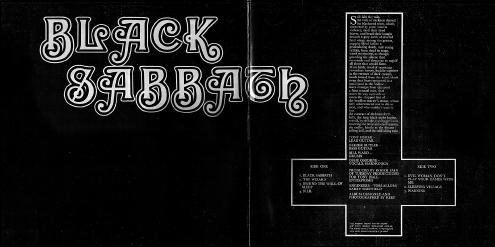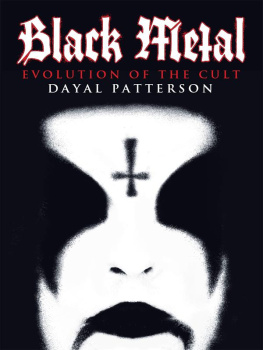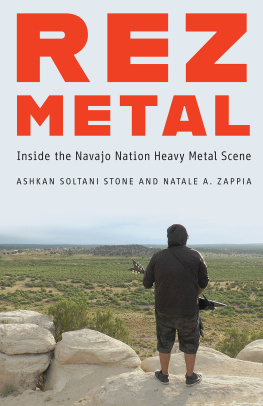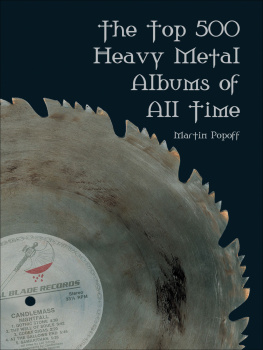
ISBN: 978-1936239757
2013 Dayal Patterson
Feral House
1240 W. Sims Way Suite 124
Port Townsend, WA 98368
www.FeralHouse.com
Design by Sean Tejaratchi
 CONTENTS
CONTENTS 


EVER SINCE ITS BIRTH in the early eightiesand especially after its rebirth in the early ninetiesblack metal has proven itself to be the most consistently thought-provoking, exhilarating, and vital of all the many offshoots of heavy metal. Truly enduring, it is a multifaceted beast, at once fiercely conservative yet fearlessly groundbreaking, undeniably visceral yet at times thoroughly cerebral. Its combination of primal, philosophical, spiritual, cultural, and artistic qualities have allowed it to transcend even its own fascinating controversies to become one of the most important forms of modern music. If you dont already agree with that statement, theres even more reason for you to read this book.
I first stumbled upon black metal while still at school, thanks to one of the now-infamousand, as we shall see, influentialexposs that Kerrang! magazine ran in the early nineties. By this point extreme metal already dominated my listening tastes thanks to bands such as Sepultura, Carcass, Bolt Thrower, and Entombed, but this (apparently) new genre appeared almost disturbingly radical and alienin fact, I distinctly remember one of the most vocal of my metal contemporaries warning me not to listen to it. By the time I left school he had cut his hair and sold his metal collection, which probably says it all.
All the same, at the time further investigation was surprisingly difficult; listening to music via the Internet was still a science fiction fantasy, record stores stocked little or nothing from the genre, and actually meeting people who listened to this music was a rarity, at least in a small town. But about a year lateras my attendance at school became somewhat less frequent and I began spending time with some slightly older metal fans from the local collegeI was given several dubbed cassettes that would have a profound impact on my listening habits and, I suppose, my life.
During the years that followed, my friends and Ilike many othersnot only sought out as much black metal music as possible but also the rare interviews with the mysterious, seemingly wraith-like characters who created it. In that sense, while this tome was officially begun in 2009, in many ways its true genesis dates back almost a decade and a half earlier. From 2004 onwards I was interviewing bands on a fairly regular basis, first for a fanzine I put together called Crypt , and later for magazines including Terrorizer and then Metal Hammer , all of which allowed me to speak to a number of the genres key protagonists. Even so, Ive realized that a major part of my motivation for writing this book was to satisfy my own curiosity and get a more rounded understanding of a phenomenon that has entranced me since my early teens.
However, another catalyst waslike black metal itselfconsiderably more reactionary. As time passed and black metal grew beyond the confines of the underground, I noticed that more and more people were covering it in various forms of media, with varying degrees of care or accuracy. At one time it seemed to me that it was better not to have black metal discussed beyond its own perimeters, but by the end of the nineties, it was clear that horse had bolted. The problem was that many of the writers and filmmakers who covered black metal were either misinformed, or focused solely upon a few strong bands and personalities to the extent that they ultimately distorted the bigger picture.
Im not suggesting that my perspective was the only right oneindeed, on some issues my opinions only formed as the book progressedbut I knew that if I attempted to cover the genres history I would at least be thorough and keep going until I felt Id captured the story. And while the publishers thought it would be helpful to begin the book with a few words about myself, most of all I hope Ive allowed some of the individuals who shaped the genre a voice to finally tell their story about the evolution of this remarkable movement.


WHEN BLACK METAL first began to really make an impact within the wider metal scene in the early ninetiesthanks to a combination of new bands, groundbreaking recordings, and the headline-grabbing Satanic terrorism taking place in Norwayit appeared from the outside to be a very new phenomenon. And in many ways it was. Almost overnight musicians had converted to the cause, with bands such as Mayhem, Darkthrone, and Burzum presenting a seemingly unified and self-contained movement with a refreshing new take on extreme metal, as well a genre-defining ideology and aesthetic.
Sure, the phrase black metal was nothing new to metal fansEnglands Venom had given birth to the term with their 1982 album of the same name, simultaneously placing themselves within, and separating themselves from, the general canon of heavy metal, a phrase used by the rock press since the late sixties. Yet this emerging second wave of black metal (as it would later be known) appeared to have taken the term and given it an entirely new meaning. The gulf between this and the first wave seemed immense, both in terms of sound and the years that had passed between the two.
So where was black metal really born? While many have found it tempting to delve back into the history of music in order to isolate examples of Satanic or occult references, the attempts to tie such references into a neat timeline of the genre are generally tenuous at best. Did it all begin with Wagners Twilight of the Gods ? Or with blues legend Robert Johnson selling his soul at the crossroads?
Well, perhaps. But in more concrete terms, black metals birth can be directly traced to the birth of metal itself. While heavy, blues-influenced rock bands such as Deep Purple and Led Zeppelin undoubtedly played an important role in this, the general consensus, and rightly so, is that metal as we know it today began largely with Black Sabbath, and in particular their self-titled debut album, recorded in 1969 and released on the auspicious date of Friday the 13th, February 1970.
Like Purple and Zeppelin, Sabbath was heavily rooted in blues rockindeed, the debut album contains two covers of blues rock numbersbut all the same, the release was a clear move toward darker and heavier territories. Whether this album marks an absolute year zero for the birth of heavy metal is naturally debatable, but theres little doubt that it was a milestone recording, effectively kick-starting both the heavy metal genre as a whole and arguably black metal itself.

Its not hard to see why the aesthetics of heavy metal godfathers Black Sabbathnot least their 1970 self-titled debut albumdid much to inspire the supernatural and Satanic obsessions of later metal bands.
Next page








 CONTENTS
CONTENTS 




